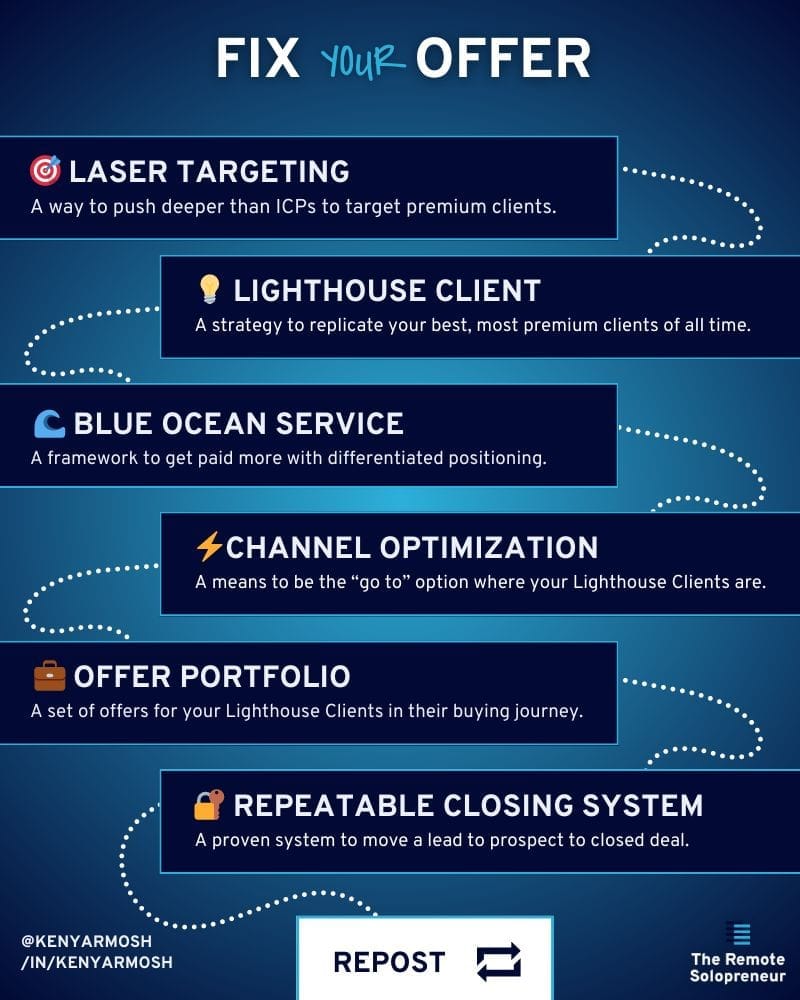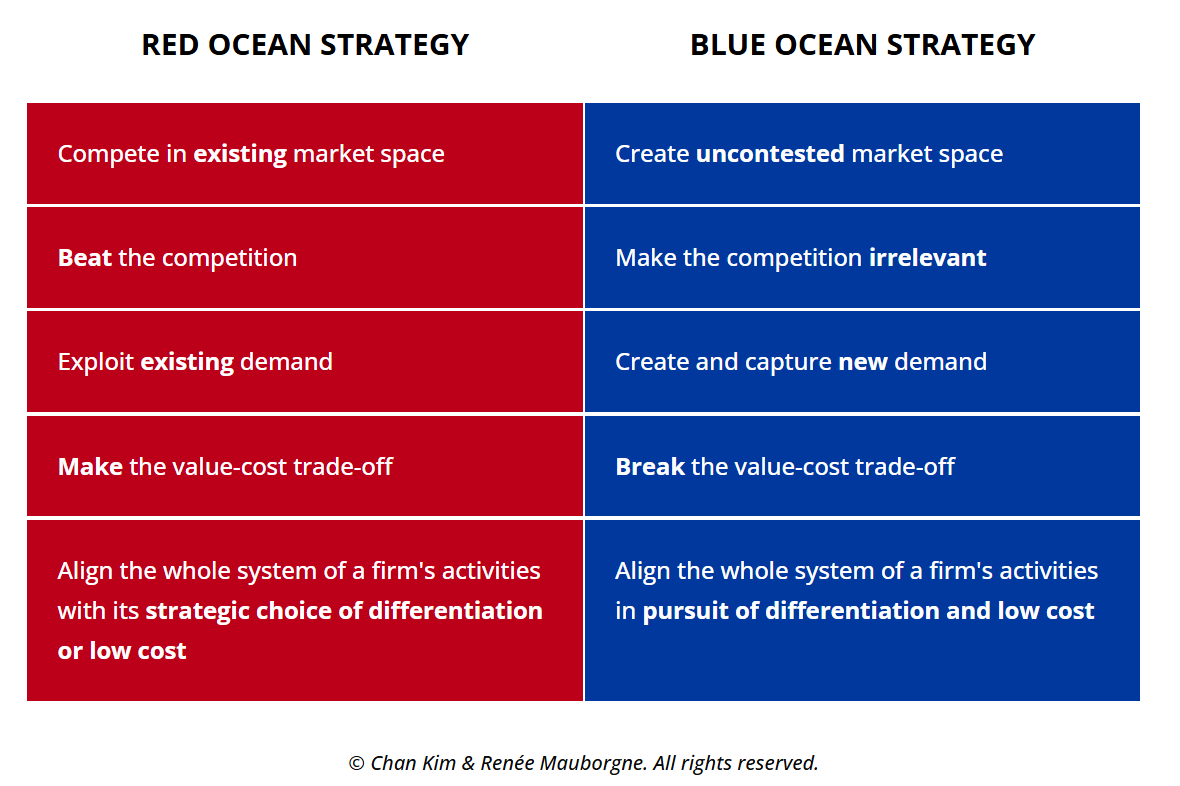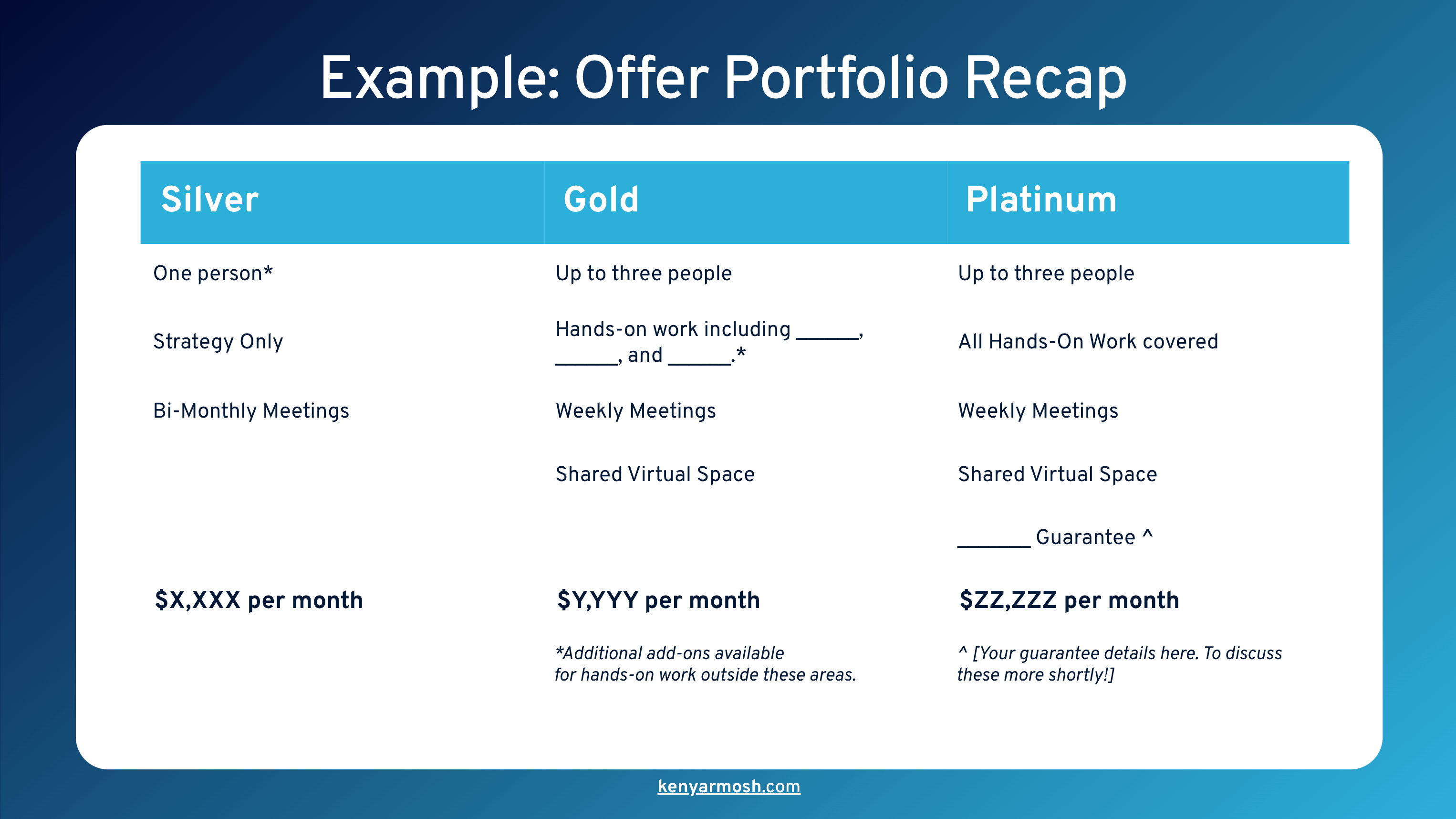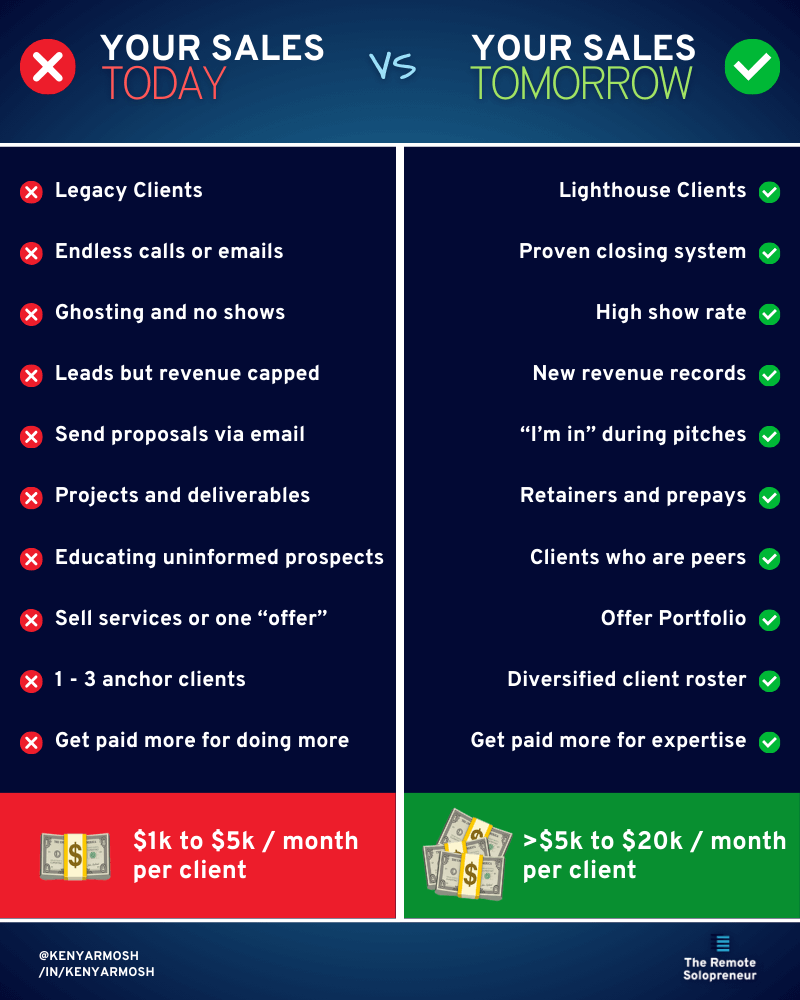🚀 TL;DR
- Service providers often undercharge because their offers are vague and undifferentiated, competing on price instead of outcomes.
- A Scalable Service Offer (SSO) is a packaged, repeatable solution that solves a defined problem for a specific audience with predictable results.
- Core elements include laser targeting, Lighthouse Clients, Blue Ocean positioning, channel optimization, a clear offer portfolio, and a repeatable closing system.
- Steps to build one: diagnose positioning, identify best-fit clients, package the transformation, create a portfolio, and implement a structured closing process.
- Best practices: model proven structures, avoid discounting in slow times, prioritize systems over hustle, transition away from legacy clients, and build for long-term scalability.
You have the skills. You deliver results.
Yet somehow, you're still competing on price instead of commanding premium retainers.
The problem isn't your expertise—it's your offer.
Most talented professionals struggle to translate what they do into something clients immediately want to buy. They list their services like a menu, hoping prospects will figure out the value. They compete with dozens of similar providers because they sound exactly like everyone else.
But what if you could position your expertise so clients saw you as the obvious choice?
After working with 551 solopreneurs, I've repeatedly seen the same transformation happen. In this guide, I’ll explain the concept of a Scalable Service Offer (“SSO”) and how you can create one.
What is a Scalable Service Offer?
A Scalable Service Offer solves a specific problem for a defined audience using a repeatable methodology. Unlike hourly consulting or custom project work, it packages your expertise into a structured solution that delivers predictable outcomes.
The shift from generic services to scalable offers represents a fundamental change in how you think about your business. Instead of selling your time, you sell your expertise. Instead of adapting to every client's processes, clients adapt to your proven methodology.
This isn't about becoming rigid or losing your personal touch.
It's about creating enough structure to deliver consistent results efficiently while clients receive the transformation they're paying for.
Traditional service providers position themselves as order-takers. A Scalable Service Offer positions you as the strategic authority with a specific solution to a particular problem.
Consider two marketing consultants:
- Generic approach: "I help businesses with their marketing needs. I can manage social media, content creation, email campaigns, SEO, and paid advertising."
- Scalable Service Offer: "I help SaaS companies increase their trial-to-paid conversion rate by 40% using my Customer Success Alignment methodology."
The second consultant immediately communicates who they serve, what outcome they deliver, and hints at their proprietary process. A SaaS company with conversion challenges knows instantly whether this person can solve their problem. The first consultant forces prospects to figure out if and how their services might help.
That extra cognitive work often leads to "let me think about it" responses instead of "let's get started."
What are the elements of a Scalable Service Offer?
Building an irresistible service offer requires six interconnected components that work together to position you as the obvious choice for your ideal client.

Laser Targeting
Most professionals cast too wide a net. They serve anyone who might benefit from their expertise. Scalable Service Offers do the opposite—they target premium clients with surgical precision.
Effective targeting goes beyond demographics to include psychographics, business challenges, and buying behaviors. You want to understand not just who your clients are, but how they think. What keeps them up at night? What motivates their purchasing decisions?
The most successful solopreneurs I work with can describe their ideal client's typical day, their biggest frustrations, and the exact words they use to describe their problems. This intimate knowledge allows them to create service offerings that feel custom-designed for their prospects.
When I was scaling my business, I discovered that established solopreneurs who wanted to grow without hiring responded differently to marketing messages than startup founders or traditional agencies. They valued independence, systems, and proven frameworks over growth hacking or venture capital strategies.
This insight shaped everything from my service packages to how I went to market with my offer.
Lighthouse Client
Your Lighthouse Client represents your absolute ideal customer—the client who pays well, works with you easily, and gets exceptional results.
Every business decision should be filtered through the question: "Does this attract more Lighthouse Clients?"
Most service providers think they need to work with anyone willing to pay them. This scarcity mindset leads to working with difficult clients, accepting lower rates, and getting stuck in delivery models that don't scale.
Lighthouse Clients pay premium rates because they understand the value of what you provide.
They implement your recommendations because they hired you for your expertise, not just your labor. They refer other similar clients because they experienced a transformation working with you.
To identify your Lighthouse Client, analyze your best past clients across these dimensions:
- They paid your highest rates with minimal price negotiation
- They implemented your recommendations quickly and completely
- They achieved measurable results that exceeded their expectations
- They referred other clients or became repeat customers
- They energized rather than drained you during the engagement
The goal? Not trying to be everything to every possible client. But instead of deeply understanding one ideal client persona and helping them achieve tangible results.
Blue Ocean Services
In crowded markets, differentiation matters more than excellence. Your offer must position your service in a way that eliminates comparison with generic alternatives.
Blue ocean positioning means finding the uncontested market space where you're not competing directly with dozens of other providers. This doesn't require inventing entirely new services—it often means combining existing expertise in unique ways or serving familiar needs in a specific way.

For example, instead of competing with every "business coach" in the market, I positioned myself as:
This positioning attracted clients who specifically didn't want the typical agency-building advice.
The key to blue ocean positioning lies in understanding what your Lighthouse Clients value that generic providers don't offer. Maybe it's your industry-specific expertise, delivery methodology, or focus on specific outcomes that drive customer success.
Channel Optimization
Being visible in the right places matters more than being visible everywhere.
Your Lighthouse Clients already spend time in specific channels, communities, and platforms. Your job is to become the recognized authority in those exact spaces.
Channel optimization means focusing your marketing efforts on the platforms your ideal clients already gather, rather than trying to build audiences from scratch on every available platform.
If your Lighthouse Clients rely on LinkedIn for professional development, become known as the authority in your niche on LinkedIn. If they participate in specific industry communities, they should become an active contributor in those communities.
I've seen consultants waste months trying to build TikTok audiences when their ideal clients were executives who primarily used LinkedIn and industry publications. The mismatch between where they were marketing and where their clients were looking created unnecessary friction in their business development.
Offer Portfolio
A well-designed service portfolio guides clients through a logical progression rather than overwhelming them with disconnected options.

This structure typically includes an entry-level engagement, a core transformation offer, and ongoing support options:
- The intro offer introduces clients to your methodology and demonstrates your expertise without requiring a massive commitment. Example: A diagnostic assessment, strategic workshop, or roadmapping project.
- Your core offer delivers the primary transformation your Lighthouse Clients need. This becomes your signature service—directly addressing their biggest challenge.
- Your premium offer gives ongoing value to your clients. For example, you might focus on ongoing implementation or similar.
These consulting offers create multiple touchpoints and deepen client relationships. This portfolio structure creates multiple revenue streams while providing natural paths for clients who want to deepen their engagement with your services.
Repeatable Closing System
Converting prospects into clients shouldn't depend on perfect sales pitches or lucky timing.
Scalable Service Offers include systematic approaches to moving qualified prospects through your sales process.
A repeatable closing system typically includes:
- Qualifying criteria to identify ideal prospects
- Structured conversation frameworks to guide discussions
- Standardized proposals that clearly communicate value
- Follow-up sequences that maintain momentum
The goal isn't to become a salesperson—it's to create a professional process that helps prospects make informed decisions about working with you. When your offer clearly addresses a specific problem for a defined audience, closing becomes about confirming fit rather than convincing reluctant prospects.
How to create a Scalable Service Offer
Transforming your expertise into a scalable offer requires a systematic approach that builds on your existing strengths while positioning them for maximum market impact.
Step 1: Diagnose your current positioning
Before building something new, understand what you're working with.
Most professionals have elements of scalable offers buried within their existing services—they just haven't packaged them effectively. Review your current services through the lens of scalability:
- Are you primarily selling time, deliverables, or outcomes?
- Do clients hire you for your process or because you're available?
- Can you deliver consistent results using repeatable methodologies?
Honest assessment often reveals that you're already solving specific problems for particular types of clients—you're just not positioning it that way. Your diagnostic work becomes the foundation for more intentional offer development.
This evaluation should examine your current brand positioning and how customer respondents perceive your company when working with you.
Do they see you as a strategic partner or a task executor? Understanding your current position helps you identify opportunities for differentiation and premium positioning.
Step 2: Identify your Lighthouse Clients
Look backward to move forward. Your best past clients provide the template for future offer development.
Create detailed profiles of your top three clients across the last two years:
- What industries were they in?
- What specific challenges were they facing?
- What outcomes did they achieve?
- How did they describe their experience working with you?
Pay particular attention to the language they used to describe their problems before working with you and the results they achieved afterward.
This language becomes the foundation for your offer messaging and helps you understand their customer personas. Also note the characteristics these clients shared beyond demographics. Did they have similar mindsets, business stages, or approaches to problem-solving?
These patterns help you identify the person who benefits most from your expertise.
Step 3: Package the transformation
Shift your focus from what you do to what clients experience after working with you.
This reframing transforms your expertise from a commodity into a strategic solution.
The transformation includes the specific outcome clients will achieve, the timeframe for completing it, and hints at your unique methodology. This positioning immediately communicates value in terms that your Lighthouse Clients understand.
Your service-based offers should focus on the end state your clients will achieve rather than the activities you'll perform to get them there.
Step 4: Build your Offer Portfolio
Rather than offering everything you can do, create a strategic progression that serves your Lighthouse Clients at different stages of their journey with you.

Your entry offer should solve an immediate problem while demonstrating your expertise and methodology. This creates a low-risk way for prospects to experience working with you while providing value that justifies your core offer pricing.
The key is making it valuable enough to justify payment while simple enough to deliver efficiently.
The core offer addresses the primary transformation your Lighthouse Clients need most. This becomes your flagship service—the offering that generates most of your revenue and establishes your market reputation.
Your Offer Portfolio should clearly communicate how these offers work together and help clients understand the natural progression path.
Step 5: Install a Repeatable Closing System
Start with clear qualifying criteria so you invest your time in conversations with potential Lighthouse Clients rather than anyone who expresses interest. This qualification might happen through your marketing content, application processes, or discovery calls.
For example, I usually recommend creating deal stages in your CRM of choice that are specific to your business. You don’t have 2 to 3 “qualifying” stages as a solopreneur.
Develop conversation frameworks that guide prospects through understanding their challenges, exploring potential solutions, and evaluating fit with your offer.
This structure helps prospects make informed decisions while positioning you as a strategic advisor. Create standardized proposals that clearly communicate the transformation you provide, your methodology for delivering it, and the investment required. These proposals should feel custom while being efficient to produce.
Your closing process should feel consultative rather than sales-focused, which helps reduce the perceived risk of working with you and shortens the sales cycle.
Clients need to trust both your expertise and your ability to deliver consistently.
Best practices for creating a Scalable Service Offer
Learning from proven models accelerates your offer development while avoiding common pitfalls that trap many service providers.
Steal from legendary offer structures
The world's most successful businesses offer structures you can adapt for professional services.
They package sophisticated capabilities into elegant solutions that customers can understand and desire immediately.
You can apply this same approach to your consulting offers by simplifying complex business solutions into clear, understandable packages that highlight outcomes rather than features.
Both strategies work for service providers, depending on your market positioning and target audience preferences.
Avoid the desperation trap
When business is slow, the temptation is to accept any project that comes along or discount your rates to win business.
These decisions often create more problems than they solve. Bad offers compound. Desperate pricing attracts clients who don't value your expertise. Custom work for everyone prevents you from developing repeatable systems.
Saying yes to everything means saying no to better opportunities.
Instead, use slow periods to refine your offer, improve your positioning, or develop new capabilities that serve your Lighthouse Clients better. This investment approach creates better long-term results than reactive price cuts.
Focus on systems, not hustle
Scaling service offers depends more on systems than personal effort.
The goal is to create repeatable processes that produce consistent results efficiently. This means documenting your methodology so others can understand and implement it. It means developing templates and frameworks that streamline delivery.
It means creating marketing systems that consistently attract qualified prospects.
Hustle culture celebrates working harder, but scalable businesses work smarter. Your competitive advantage comes from better systems, not outworking your competition.
Always include documented processes from initial client contact to project completion and follow-up.
This systematic approach allows you to maintain quality while increasing capacity.
Don't anchor to legacy clients
One of the biggest obstacles to implementing scalable offers is existing clients who operate under old models.
These relationships can feel comfortable, but often prevent you from pursuing better opportunities. Legacy clients expect custom work, discount pricing, or unlimited revisions because that's how your relationship started. Changing these dynamics requires difficult conversations and boundary setting.

The alternative is remaining trapped by past decisions.
Your business grows in the direction of your current clients. If those clients don't represent where you want to go, you need to make strategic changes to your client roster. This doesn't mean firing good clients overnight.
It means gradually transitioning your business model while being selective about new clients.
Play the long game
Scalable Service Offers create leverage that compounds over time.
Shorter sales cycles, better clients, and more predictable revenue all result from having structured, clear offers that address specific market needs. The goal isn't just immediate revenue—it's building a sustainable business model that grows more valuable and efficient over time.
Your core service offerings should be designed to create customer success stories that attract more ideal clients through referrals and social proof.
This organic growth is more sustainable than constantly chasing new prospects through paid advertising or cold outreach. Consider how your offers contribute to the digital transformation goals of your target market.
Position yourself as a strategic partner in their long-term success rather than a vendor providing temporary solutions.
Transform your expertise into premium offers
The difference between struggling service providers and those commanding premium rates isn't talent or experience—it's offer structure.
Your expertise has value independent of time investment. The insight that saves a client millions might take minutes to identify, but its value isn't measured in minutes.
The strategy that doubles their revenue isn't worth less because you can develop it efficiently.
You and your clients benefit when you package transformation instead of time. You capture value commensurate with outcomes you create. Clients get results that justify their investment.
Scalable Service Offers position your expertise as the solution to specific problems rather than time available for generic work.
This positioning allows you to build a service business that rewards your knowledge and delivers genuine customer success. That's the power of truly irresistible service offers.

